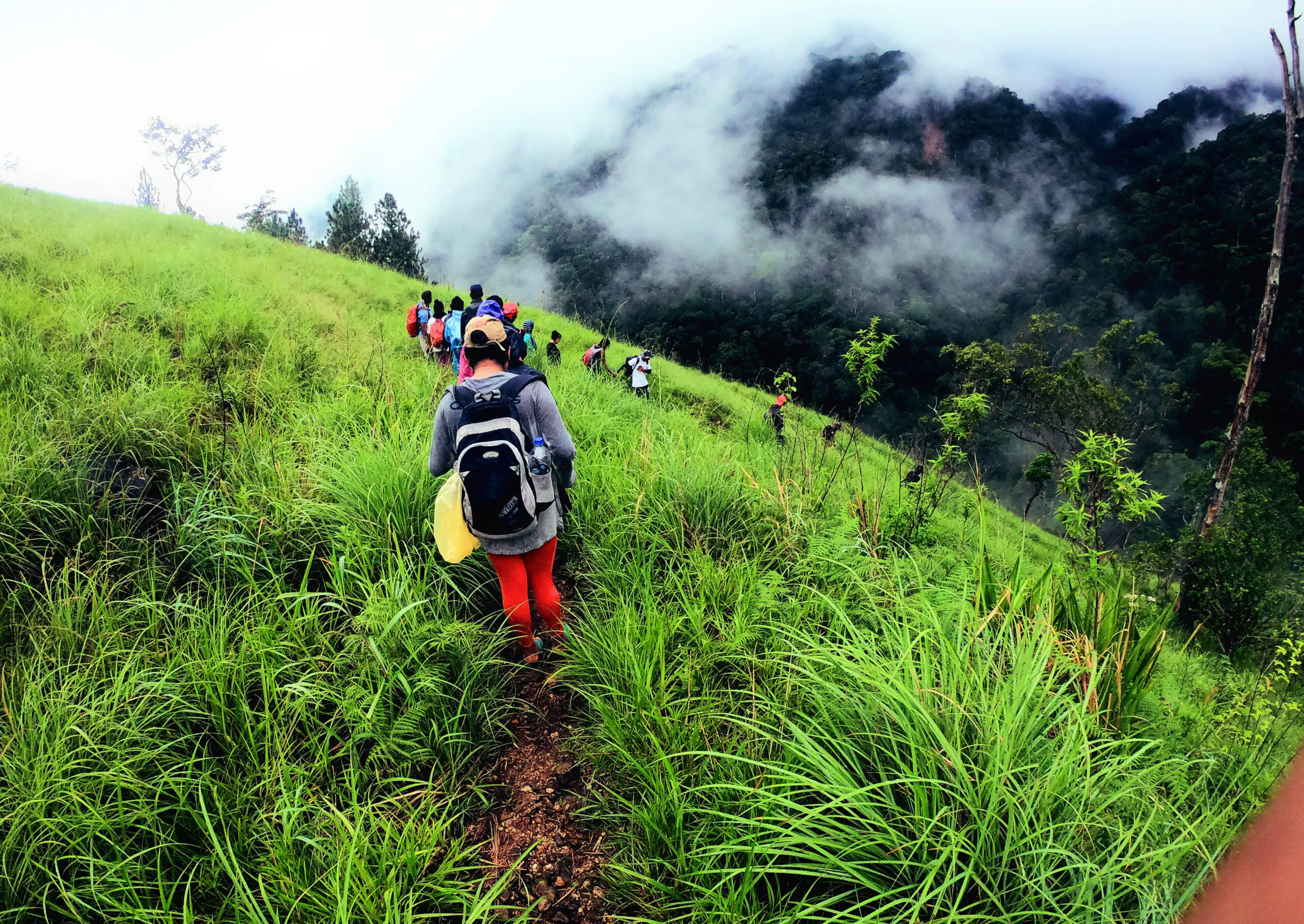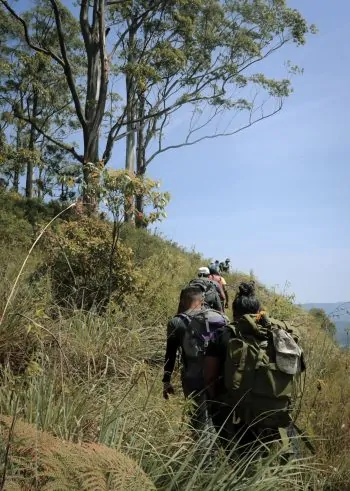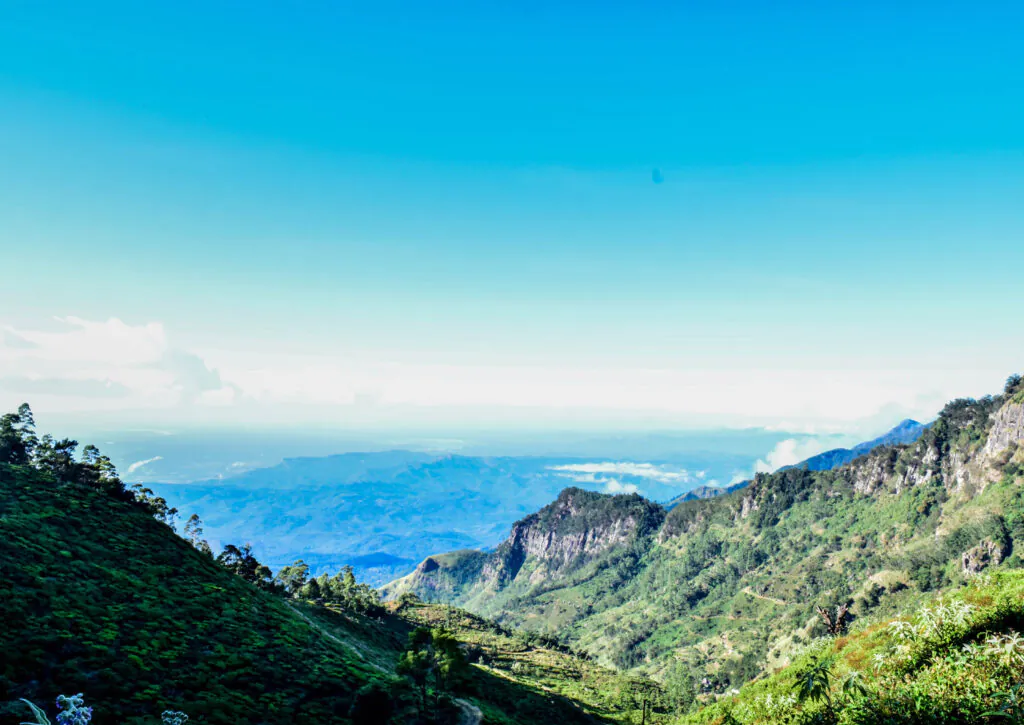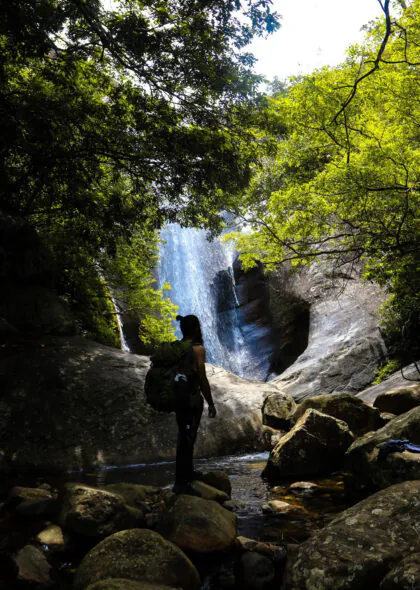Menu

One of the most popular four wheel and hiking tracks in the hill country of Sri Lanka is the Devils Staircase in Ohiya. It is a norm among Sri Lankan hikers that every hiker should walk in this path, at least once in your lifetime if you are so passionate about hiking. Difficulty levels and the marvelous view of the green mountains and tea states of Sri Lanka has made this route a trekkers paradise, but if you want to see this beauty there is only one requirement, that is, you should be fit enough to walk 20 km either to climb up or all the way down or your 4×4 Jeep is fit enough to take you there.
Our team consists of five members, Oshini, Melani, Chulan, Yasith and me. This time we have decided to walk from the Ohiya railway station to Kalupahana Junction, but it’s about 20 km and there are several waypoints. 1. From Ohiya situation to the Devils Stair case truing point – 4 km. 2. From turning point to Bambarakanda waterfall – 9km and 3. From waterfall to Kalupahana junction is 7 km. This is my first time walking on this route, and same as others, but we had a great faith on our feet that we can finish this amazing trail and we were waiting to finish this. Normally hikers start this trial form Bambarakanda to Ohiya but we decide to go other way.


We came by the Colombo – Badulla night mail train and raced to the Ohiya Station by 5.00 am, it was cold as an ice age when we just got outside of the train coach. After having some rest we started our great journey at 6.00 am in the beautiful morning. As I mentioned earlier, this is our first time and we didn’t have any guide to show the trail, but I did my homework on this trail, and with the help of GPS unit we walk. Sometimes we asked direction from random people we met on the trail, those innocent and kind villagers offered their help to us and they even walked with us for some distance to show the trail. With all of that we were able to reach to our endpoint.
From Ohiya Station to Devils staircase turning point road which is the one leads to Horton Plains, this road was well maintained tar road with an elevation. It was an amazing feeling that you will get by walking on this road, both sides of the road were covered with large pine and turpentine trees, and with the richness of pure oxygen to breathe. With the rising sun from the east gives us the warmth we were looking for with her shiny yellowish rays, with the glory of the environment and our little chit chats facilitated us to climb up along the road but it took around two hours to reach to the first waypoint.
We took a left turn from that waypoint, and this downhill road leads all the way to kalupahana Junction, filled with the magnificence of the countryside, edge cliffs, narrow road contains 32 nos of hairpin bends suited only to 4×4 Jeep adventure. But this time we had to walk all the way down to see the beauty of the green mountains and it was an amazing experience for all of us. For the first time if you see this path, I have no doubt you’ll lose your breath for a while, that view is so astonished and you may want to stay for a while and see the elegance of the mother nature’s beauty.
You may think that climbing down easy on a downhill road or from the mountain, believe me it’s not, sometimes it’s harder than climbing up. Most of the time we have to put the brakes on to our legs and the road is not level, sometimes you will find rocky road, and sometimes it’s covered with the grass and even from the soil and granite. First few kilometres we were going through the normal road through the hair clip bends, but then we decided to go through the tea state not going round and round. This is the path most villagers take, they don’t walk in the road they go through the tea plants, and we knew it’s risky, but couldn’t help because we have to complete our journey before the Rail fall.
It took almost 3 hours to reach to the Udeweriya village from the turning point and five of us was walking alone and we only met a couple of people who are working in the tea estate. Around 12 PM mist came down and block our path, and it was white as snow. The puckers in the village were so generously even they offered us the pure hot plain tea. I’ve never tasted that much of a freshness and the taste in my whole life. I have learned one big thing from them that is their lifestyle was very simple and they only had fewer numbers of needs and wants go their day-to-day life, we are the ones who have put the complexity into our life’s and suffers day by the day. If you want to be happy there is only one thing that you have to do, that is “Be Simple”.



After thanking them on their warm hospitality we walk again to our final destination, the most awaited Bambara Kanda Falls by the time of 2.30 PM we were lucky enough to reach to our final destination. We have walked through the legendary V cut on this trail and from this point onwards the road was constructed properly, even a car can come up to this point.
Nestled within the lush landscapes of Sri Lanka, Bambarakanda stands tall and proud as the island nation’s highest waterfall. Tucked away in the central hills of the Badulla district, this natural marvel is a testament to the captivating beauty that defines Sri Lanka’s diverse topography. As travelers seek to explore the hidden gems of this tropical paradise, Bambarakanda stands out as a must-visit destination, offering a mesmerizing experience for nature lovers and adventure seekers alike.
Bambarakanda waterfall, with a staggering height of approximately 263 meters (863 feet), cascades down the rocky cliffs of the Horton Plains National Park. The waterfall is fed by the waters of the Kuda Oya, a tributary of the Walawe River, creating a breathtaking display of nature’s power and grace. Surrounded by dense forests and mist-covered mountains, the area exudes an aura of tranquility that transports visitors to a serene world far removed from the hustle and bustle of everyday life.
Upon reaching the viewing platform, travelers are rewarded with a breathtaking panorama of Bambarakanda’s majestic descent. The waterfall plunges gracefully into a rocky pool, creating a fine mist that adds to the ethereal atmosphere. The surrounding cliffs are draped in emerald-green vegetation, enhancing the visual allure of this natural masterpiece.
Bambarakanda stands as a testament to the extraordinary beauty that defines Sri Lanka. Its towering presence, combined with the surrounding landscapes and the sense of adventure it offers, makes it a destination that leaves an indelible mark on those fortunate enough to experience it. As travelers seek refuge in the embrace of nature, Bambarakanda beckons, inviting them to discover the magic of Sri Lanka’s tallest waterfall.
Accessing Bambarakanda is an adventure in itself. The journey typically begins from the town of Haputale, a charming hill station renowned for its scenic beauty. Travelers can embark on a picturesque drive through winding roads, passing through tea estates and quaint villages. The journey provides glimpses of Sri Lanka’s rural life, with friendly locals and panoramic views creating an immersive experience.
As visitors approach Bambarakanda, the distant sound of cascading water becomes increasingly audible, building anticipation for the grand spectacle that awaits. The final stretch of the journey involves a trek through verdant trails, surrounded by a rich tapestry of flora and fauna.
When we came to Kalupahana Junction and took a bus to Haputale Town and it was coming back to the human civilization, by the night mail trail we came to our homes dreaming about our next adventure. As everything has a beginning and has an end, we have archived our goal of walking on this Devils Staircase, but our journeys won’t stop, we still got quenched for the hiking it gives us amazing experience and building relationships with the nature. I have only one request from you all that is pleasing preserve the beauty of this amazing route for the future generations.


Lanka Ella, which translates to “Sri Lankan waterfall,” is a captivating cascade that emerges from the hills of the Badulla district. With a height of approximately 30 meters (98 feet), the waterfall descends gracefully, creating a mesmerizing spectacle against the backdrop of the lush greenery that surrounds it. The serenity of the location, coupled with the soothing sounds of cascading water, transports visitors to a realm of tranquility and natural harmony.
The journey to Lanka Ella is an adventure in itself, as travelers navigate through winding paths and dense forests to reach this secluded paradise. The trail leading to the waterfall is a mix of natural pathways and man-made steps, creating an immersive trekking experience for those willing to explore the untamed wilderness. Along the way, the air is filled with the fragrance of exotic flora, and the sounds of birds and insects create a symphony that complements the serenity of the surroundings.
Upon reaching the base of Lanka Ella, visitors are greeted by crystal-clear pools formed by the cascading water. The pools provide a refreshing respite for those looking to cool off after the trek. The fine mist rising from the waterfall creates a microclimate, enveloping the area in a refreshing embrace that invigorates the senses. It’s a perfect spot to take a dip or simply sit by the water’s edge and absorb the tranquil ambiance. As travelers tread the paths to Lanka Ella, they discover not just a waterfall but a sanctuary where nature’s poetry comes alive, leaving an indelible mark on their hearts.
Strolling through the village, interacting with the locals, and receiving warm greetings from their little children filled us with excitement, making us feel truly at home. The location, surrounded by lush greenery and flowers, is incredibly secluded and features charming stairways, creating an overall stunning atmosphere. Upon arrival, the two housekeepers, dedicated to ensuring guests’ comfort, welcomed us with a refreshing serving of black tea with ginger.
The accommodation offers numerous rooms, each equipped with at least four beds. While the rooms are basic, they are impeccably clean, boasting well-maintained bathrooms. For avid hikers, the amenities exceeded expectations compared to other options. To enhance our stay, they provided soap and fresh towels, along with hangers for drying clothes.
Despite the absence of Wi-Fi and a working local network, we embraced the lack of connectivity, engaging in meaningful conversations outdoors and immersing ourselves in nature. The cook inquired about our preferred dinner time, promptly delivering a homemade, authentic Sri Lankan meal, featuring vegetables sourced from the garden. The option to purchase local beer and bottled water was also available. The chilly night did not hinder our sleep, as exhaustion from the day’s trek left us in need of a restful night for the upcoming hike. Additional blankets were provided for those feeling colder, ensuring our comfort.
Breakfast, also homemade and simple, proved to be delicious. While the overall setting appeared somewhat outdated and in need of an upgrade, particularly the living room, we still highly recommend the place. It offers a unique opportunity to disconnect from the world and explore a lesser-known part of Sri Lanka.
In conclusion, our stay was an extraordinary and memorable experience that will linger in our memories for years. The local children, friendly and welcoming, greatly appreciate stationery items, especially pens, which can be a thoughtful gesture considering many of them endure long walks to reach their schools.

This is undeniably the perfect destination for detaching from everyday life and immersing yourself in nature. With a direct vista of Sri Lanka’s tallest waterfall – Bambarakanda Waterfall, the view from the Glamping tent is absolutely awe-inspiring. Additionally, they offer delectable dishes that are genuinely tantalizing, and the dining experience comes with a backdrop of the majestic waterfall. The level of hospitality is extraordinary, accommodating our requests and organizing trekking/hiking activities. I highly endorse this place for a rejuvenating and nature-filled getaway
WhatsApp us